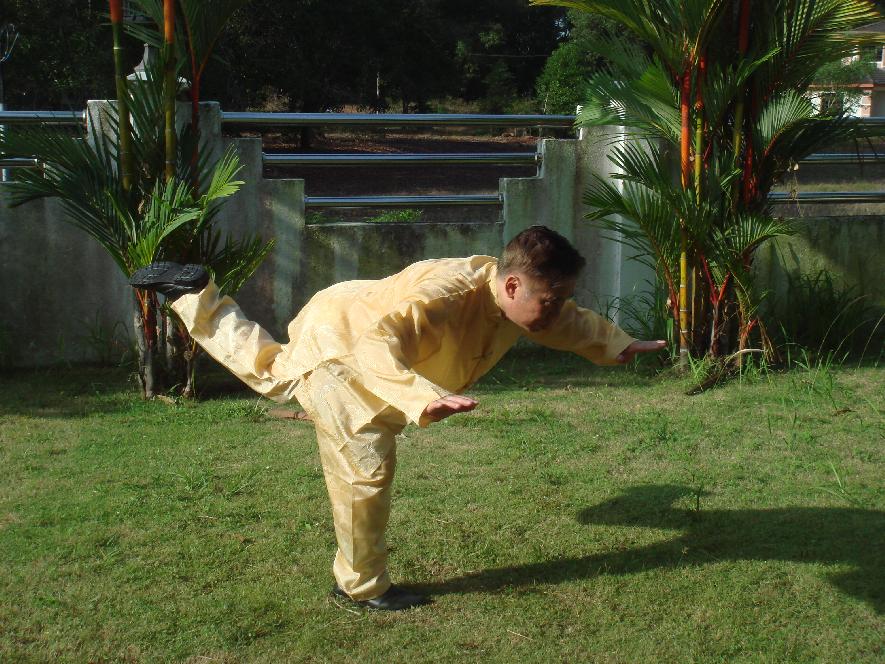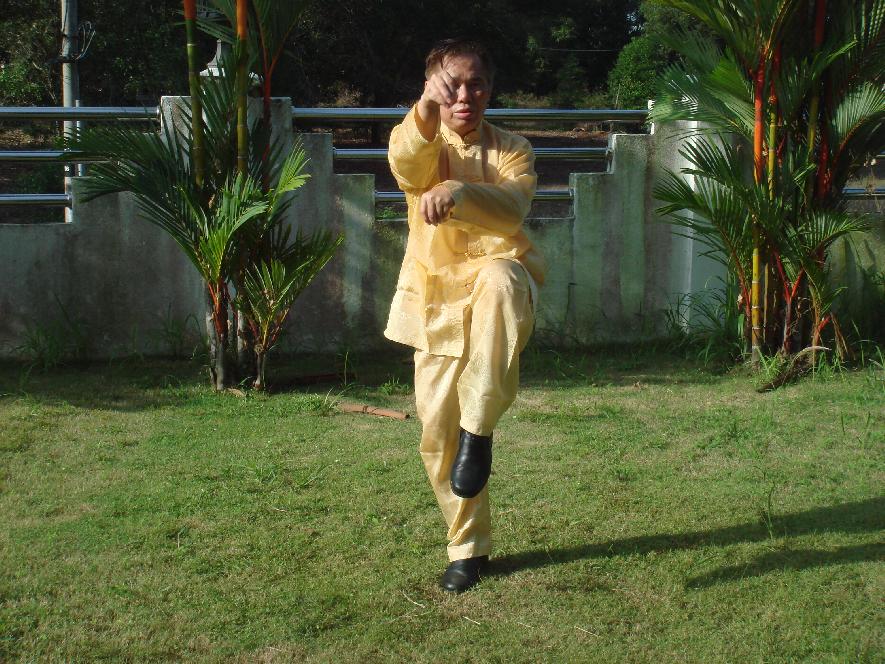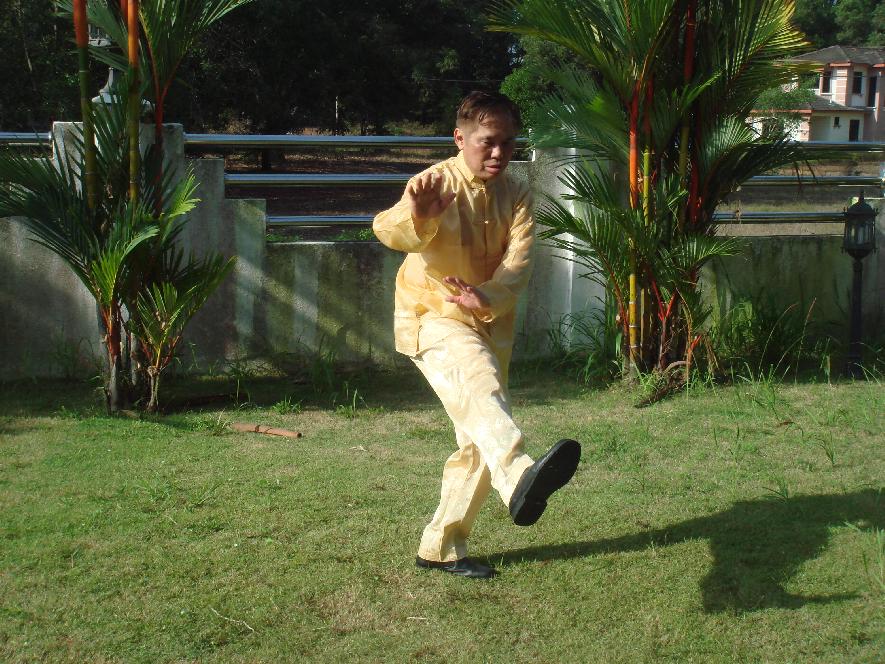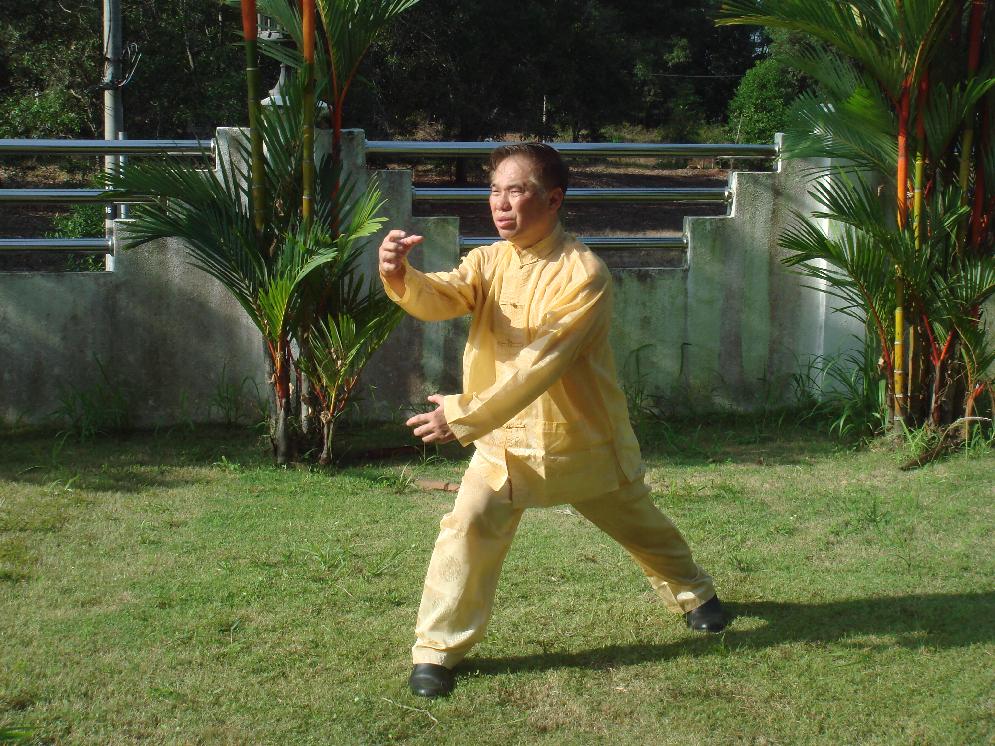SELECTION OF QUESTIONS AND ANSWERS
JANUARY 2011 PART 1

A beautiful pattern, "Dragonfly Dots Water", from the Shaolin Great Majestic Set
Question 1
Sifu,
Our students are happy that you teach so many famous kungfu sets this year. But some are worried whether learning many kungfu sets may slow down their progress. Can you please give your views on this?
— Sifu Roland Mastel, Switzerland
Answer
Your questions come at an excellent time. My answers will not only disperse many of the students' doubts, but also contribute much to their training.
In my young days I spent a lot of time meeting famous kungfu masters and if opportunities arose I learned important sets from them. I also exchanged many kungfu sets with classmates and friends, as well as learned signature sets from good books. It was quite easy for me to learn any sets if I wanted. I only had to watch a set performed a few times, and I could then remember it. If I wanted it to be in my kungfu repertoire, I would practice it many times at home to be familiar with it.
Videos were unknown then, and photographs were expensive. So I often recorded pattern names of important sets in my private note books. My knowledge of pattern names came in very useful. Nevertheless, I could only record the pattern names, but not their actual movements. Hence, years later when I tried to reconstruct the movements from the names, I might not be able to reproduce the exact movements as I first learned them.
I mentioned in my autobiography, which has yet to be published but which Robin has kindly posted in our Virtual Kwoon, that the kungfu sets I "stole" by learning them secretly while my classmates performed them in their practice did not add to my kungfu performance or attainment. This was true before my learning from Sifu Ho Fatt Nam. But after my "kungfu enlightenment" from Sifu Ho Fatt Nam, the sets I had learned earlier and more sets I was to learn later became meaningful and very useful.
Many people have been amazed at my kungfu understanding. I could watch someone perform his favorite set which I did not know earlier, then tell him the applications of the patterns as well as other aspects of the set that he himself did not know. I owed much of this ability to my having learnt and practiced many kungfu sets.
It is true that learning many kungfu sets may slow down the progress of some students, but to me it is obviously very beneficial. Now I can also share these benefits with instructors and students of our school.
Why do our students benefit much from learning many kungfu sets whereas for other people this may be detrimental? It is because if people do not understand the sets, the more they learn the more they become confused. They may know the routine of the sets well, and even perform them beautifully, but if they do not understand the deeper meaning of the sets and their applications for combat as well as for daily life, these sets remain just as routines of external forms for physical exercise or for demonstration. These sets do not add to their combat efficiency or daily life.
But once they have insight into the sets, the more they learn the more they benefit and enjoy. The sets contribute to their combat efficiency, effectiveness in daily life, health, vitality, longevity, mental freshness, and spiritual joys.
It is the same with all other things in life, like solving mathematical problems and meeting new people. If one does not know how to solve mathematical problems, or do not know the people, the more problems or people he meets, the more confused he becomes. But when he knows how to solve the problems or the people have become his friends, he will appreciate them.
Question 2
The sets you taught us in our basic syllabus were not these classical kungfu sets. We have benefited very much from the new sets. But can you please tell us why you chose to teach us the new sets, like "Black Tiger Steals Heart" and "Fierce Tiger Speeds through Valley", instead of classical sets like "Taming the Tiger" and "Praying Mantis Eighteen-Collection"?
Answer
These are important questions that reveal many interesting features of our school, like our philosophy and history as well as the development in our teaching methodology.
While we value non-combat benefits like good health and vitality more than combat efficiency, we still emphasize that if we practice kungfu we must be able to use it for combat. Indeed, the main reason for founding Shaolin Wahnam was to perverse and pass on to posterity the greatness and wonderful benefits of Shaolin Kungfu and Shaolin Cosmos Chi Kung. (Taijiquan was later added.) Of course this includes combat efficiency. We would be mocking ourselves if we could not use Shaolin Kungfu for fighting.
I researched into how Shaolin Kungfu was taught in the Shaolin Temple in the past, and found that students started not by learning kungfu sets but by practicing basics like stance training, footwork, fundamental patterns, specific applications and combat sequences. Later the patterns and sequences were linked into sets. This was also how I learned from Sifu Ho Fatt Nam, who was only three generations from the southern Shaolin Temple at Quanzhou when it was burnt by the Qing Army.
However, I found the basic patterns I learned from Sifu Ho Fatt Nam, and the first set I learned from Uncle Righteousness too advanced for today's beginning students. From Sifu Ho Fatt Nam I first learned patterns like One-Finger Shooting Zen, Butterfly Palms, Night Tiger Emerges from Jungle, Dragonfly Dots Water, Gold Coin on Ground, Tiger-Tail Kick, Old Dragon Squats on Ground, and Rising Dragon Leaping Tiger. These patterns were linked to form the Great Majestic Set. Four-Gates, the fundamental set, came later, followed by "specialized" sets like Pakua, Seven Stars and Lohan.
Sifu Ho Fatt Nam's teaching methods were quite different from those of Uncle Righteousness, my first kungfu teacher. Like other kungfu teachers, Uncle Righteousness started with stance training. The difference, however, was that he placed much more emphasis on stance training than most other kungfu teachers. Then we went on to sets. The first set I learned was Tiger-Crane, followed by Dragon-Strength, and weapon sets like Flag-Waving Staff and Butterfly Knives. I also "stole" Flower Set and Triple Stretch by watching my classmates practice. Uncle Righteousness' treasure, Essence of Shaolin, was taught to me much later. He took more than two years to teach me this set.
When I first founded Shaolin Wahnam Association in Sungai Petani, I used One-Finger Shooting Zen for force training, and Four-Gates as the fundamental set. I also taught specific techniques like how to counter various strikes and kicks, neutralize felling attacks and escape from chin-na techniques. At more advanced levels I taught Pakua, Taming the Tiger, Flower Set and Triple Stretch, as well as weapons like the staff, saber, sword, spear and Guan Dao. To help students use kungfu patterns effectively in combat, I composed 12 combat sequences.
Later when I established Shaolin Wahnam Institute I expanded the 12 combat sequences to 20, and made them more systematic with 8 sequences for striking, and 4 each for kicking, felling and chin-na. These 20 combat sequences were linked to form 5 sets, with 4 sequences in each set. The five sets are "Black Tiger Steals Heart", which is composed from Combat Sequences 1 to 4, "Fierce Tiger Speeds through Valley" from Combat Sequences 5 to 8, "Happy Bird Hops up Branch" from Combat Sequences 9 to 12, "Fell Tree with Roots" from Combat Sequences 13 to 16, and "Fierce Tiger Descends Mountain" from Combat Sequences 17 to 20.
However, when I taught these combat sequences in Intensive Shaolin Kungfu Courses, I could have time to teach only 12. Later with the help of videos, I could teach 16. I was quite satisfied with 16 combat sequences because although the last 4 sequences, i.e. Combat Sequences 17 to 20, specially deal with chin-na, chin-na techniques are also found in Combat Sequences 13 to 16 which actually deal with felling techniques. Hence, with the 16 combat sequences, our students are sufficiently equipped to deal with all types of attacks, namely striking, kicking, felling and chin-na.
So when I devised our Shaolin syllabus covering 3 stages and 12 levels, I included only the 16 combat sequences, leaving the remain 4 sequences for specialized or advanced training. I did try to include these 4 remaining sequences into our basic syllabus, but it is already so full and comprehensive, that adding 4 more combat sequences might overload it. Nevertheless, with our continually improved teaching methodology, I may add these 4 sequences into our basic syllabus in future.
As it can be seen from this brief historical account, the main reason why I chose to teach new kungfu sets composed by me instead of classical sets passed down from tradition although I knew many of these classical sets, was to meet expedient needs. If I taught classical sets, our students would need three years before they could use kungfu effectively for free sparring and real fighting. But with the new sets they could do so in six months. Nevertheless, I believe that these new sets will become classical sets in future.

"Single-Leg Flying Crane" from the Tiger-Crane Set, the first kungfu set Grandmaster Wong ever learned. At that time Gramdmaster Wong had no idea what the pattern was for. He understood its profound combat application much later.
Question 3
What inspired you to teach the classical sets later on?
Answer
I know many classical sets, some of which were well-known ones practiced by famous past masters, like Triple Stretch practiced by the Venerable Sam Tuck and Hoong Hei Kwoon, Taming the Tiger by Loke Ah Choy, Flower Set by Foong Sai Yoke and Wu Wei Thien, and Iron-Wire by Thiet Kiew Sam.
I also know some little-known but greatly treasured sets, like San Chan from Wuzu Kungfu, Siu Lin Tou from Choe Family Wing Choon, Pakua which was instrumental for my "kungfu enlightenment", Seven Stars which is excellent for small-sized exponents against stronger opponents, Monkey Set for which Sifu Ho Fatt Nam was expert at, Dragon-Strength which is a masterpiece of internal force and speed, and Essence of Shaolin which was Uncle Righteousness' best. They are little known because masters who practiced them kept them as secrets. There are also famous classical sets I learned from various sources, like Twelve Sequences of Tan Tui from Northern Shaolin, 50 Sequences of Eagle Claw, Eighteen-Collection from Praying Mantis and Drunken Eight Immortals from Taoist Kungfu.
I thought it would be a great pity if I did not teach these famous and treasured sets to deserving students in our school, so that they would pass them on to posterity.
So, for students who have completed the basic syllabus, I teach them selected sets like Tiger-Crane, Dragon-Tiger, Dragon Style, Five Animals, Monkey Set and Pakua. In some intensive or regional courses, I teach Tantui, 50 Sequences of Eagle Claw, Iron-Wire, Taming Tiger, Siu Lin Tou, Eighteen-Collection and Flower Set. Not only these students will pass on the sets to posterity, their training the sets have greatly enriched their kungfu performance as well as daily life.
Question 4
I understand that practicing Praying Mantis will add to my Monkey Style because these two styles are similar in many ways. But will practicing Praying Mantis be detrimental to a different style like Wing Choon?
Answer
For many people, practicing two or more different styles will be detrimental to their kungfu progress. This is because the different styles conflict with one another. For example, Wing Choon techniques are generally short-ranged, whereas Praying Mantis techniques are long-ranged. Someone used to short-ranged techniques would be at a disadvantage when required to use long-ranged techniques, and vice versa. Taijiquan techniques are generally soft and circular, whereas Tantui techniques are generally hard and straight. Someone trained in soft and circular would be at a disadvantage when this training is used for hard and straight techniques, and vice versa.
However, for Shaolin Wahnam students these different styles will complement one another and enhance not only their kungfu attainment but also their daily life. I am aware that some people may not be happy with what I shall explain, and may accuse us for being boastful or conceited. As I have mentioned a few times, that is their business, but we are not afraid to speak the truth for the benefit of our students as well as other people who share our philosophy.
Why is it that practicing different styles will be detrimental to many people but contributing to us? It is because of the different nature and scope of training between other people and us. Other people train only the external form of the different styles, and seldom go deep into kungfu basics or the philosophy of these different styles. For example, they train the form of Wing Choon sets, and then the form of Tantui sequences. From this approach, as Wing Choon form is very different from Tantui form, training the two different styles together will be detrimental.
Our approach is different. We do not start with Wing Choon sets or Tantui sequences; we start with kungfu basics like stances, footwork, hand forms, exploding force, breath control, chi flow and mental focus, which can be applied to any styles. With this foundation, when we learn Wing Choon, Tantui or any other style, we experience different applications of the kungfu basics.
For example, other people learn how to perform a short strike using a short stance in Wing Choon, and then learn how to perform a long strike using a long stance in Tantui. As these two forms are diametrically different, they distract from each other. When they perform Wing Choon, their training in Tantui interferes with their Wing Choon movement. When they perform Tantui, their Wing Choon training interferes with their Tantui movement.
Our approach is different. We do not merely learn a Wing Choon strike or a Tantui strike. We learn how to make a strike using a stance. We do not just limit our short strike to a short stance, we may also use a long stance. Similarly we do not just limit our long strike to a long stance, we may also use a short stance. Hence, when we learn Wing Choon, Tantui or any other style, it provides a structure for us to apply what we have trained. Indeed, the more styles we learn, the more structures we have, which results in us becoming more combat efficient.
Moreover, we also learn kungfu philosophy in general as well as Wing Choon philosophy and Tantui philosophy in particular. This gives insight and meaning to our application. We know, for example, the advantages and disadvantages between short-range and long-range combat, and shall choose an appropriate strike using an appropriate stance to minimize disadvantages and maximize advantages.
When other people use a short strike in a short stance, they call it Wing Choon Kungfu. When they use a long strike in a long stance, they call it Tantui. But they would not use a short strike in a long stance, or a long strike in a short stance. If they did, their classmates would criticize them, saying that their form was neither Wing Choon nor Tantui. They have become a slave to their form.
We do not face such self-imposed restriction. If someone criticizes us saying that our form is neither Wing Choon nor Tantui, we reply by saying that kungfu is alive, and we make an appropriate modification to suit the situation. To us our forms are our tools, they serve our purpose, not we enslave ourselves to them.
This does not mean we would readily disregard our form. We would not, for example, substitute a Wing Choon or a Tantui strike with a Boxing jab, or substitute a short stance or a long stance with bouncing about. We would not do so not because we are afraid of criticism -- indeed, if it were advantageous to do so, we would -- but because from both philosophy and experience we have found that using Wing Choon, Tantui or any kungfu form enables us to be more combat efficient than jabbing and bouncing about.
Editorial Not
: Sifu Roland Mastel's other questions can be found at
January 2011 Part 2.

"Clutch Kick Technique of Immortal Li", a pattern from the Drunken Eight Immortals which is very effective for leg work
Question 5
I notice in "The Complete Book of Tai Chi Chuan", reference is made to Wudang Taiji Quan. Do you teach this style?
— Mark, USA
Answer
We do not teach Wudang Taijquan or any other style of Taijiquan. What we teach is Wahnam Taijiquan
Question 6
Would you please answer a question about zhan zhuang? Does one exhale through the mouth or through the nose when practicing zhan zhuang -- be it Standing Zen or horse stance?
I apologize if this is a poor question. It is just that I do not believe I have ever noticed before and I cannot seem to practice zhan zhuang right. You told us (1) not to worry (2) avoid intellectualizing and (3) enjoy ourselves. I have tried this approach but I cannot teach myself.
Answer
When practicing zhan zhaung, you may exhale through the mouth or through the nose. though it is generally better through the mouth. But the best is you do not have to be conscious of your breathing. It doesn't matter whether you are exhaling through your nose or mouth.
Indeed often many of our advanced practitioners suddenly discovered that they were not breathing at all, i.e. in the Western sense of breathing in air and breathing out air. But they were breathing in the classical sense of taking in and giving our energy. This exchange of energy is not just through the nose and mouth, but through the dan tian or the whole body.
Yours is a good question. Nevertheless, you should not worry or intellectualize. Just enjoy your practice. It can be easily done if you just do it. It is like eating your food. Don't worry whether it should be cooked a bit longer or shorter, or intellectualize what would the benefits be if it is cooked a bit longer. Just eat and enjoy your food.

"Gold Thread Suspends Gourd", a chin-na technique from "Essence of Shaolin", Grandmaster Wong's cherished set
Question 7
I am practicing some of the exercises described in Master's book, The Art of Chi Kung, like "Lifting the Sky" and "Carrying the Moon" everyday for one week now. Today, after finishing the exercises I stood for 15 minutes and I started to move my hands and shoulders from the chi going in my body. After I had finished I began to feel nausea and generally I was not feeling well. Now two hours later I am still in the same condition.
— Dina, Greece
Answer
The movement of your hands and shoulders was due to chi flow that you had generated from the exercise. This was a good sign. It showed that you had practiced correctly.
Your feeling of nausea and being unwell was due to one, two or all of the following factors:
- You closed your mouth.
- You tensed your muscles.
- You were thinking of many things.
Closing your mouth, tensing your muscles or thinking of many things during chi flow would interupt the flow and cause chi to be locked in your body or head. This would make you feel nausea or unwell.
If this happens only once a while, it is not serious. Continue your practice and correct these mistakes, and the feeling of nausea and being unwell will soon be replaced with a feeling of freshness and well-being.
Question 8
There are no chi gong practitioners here in my city. I am doing those exercises because I saw very good results in a hip osteoarthritis problem that I face. I would be grateful if you can help me to understand what went wrong, if those exercises are dangerous for health, if they have side effects and what I can do in order to avoid this in future.
Answer
Congratulations for having good result regarding your osteoarthritus problem. Continue with your practice. Not only your problem will be overcome, but also you will have other benefits.
The exercises are safe. You need to follow the instructions respectfully, like being relaxed, opening your mouth gently and not thinking of anything. But do not add anything extra to the instructions, like being over zealous in checking your forms are perfect or wearing crystals to enhance results!
Of course, you will get much better result if you learn personally from our certified instructors. The difference is incomparable.
LINKS
Selected Reading
- The Blessing and Responsibility of Being a Husband and Father
- I Dance, I Enjoy, I Live
- Kungfu Forms, Kick-Boxing and Chi Kung
- Striking Tiger Poise Against Any Kicks
- Shaolin Thirty Six Specific Techniques
